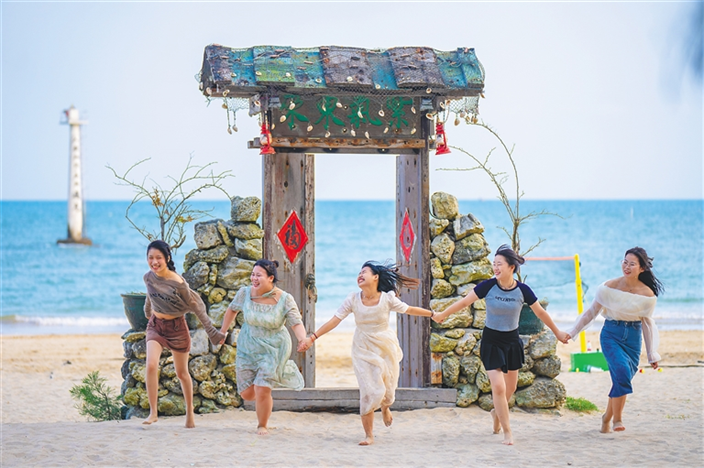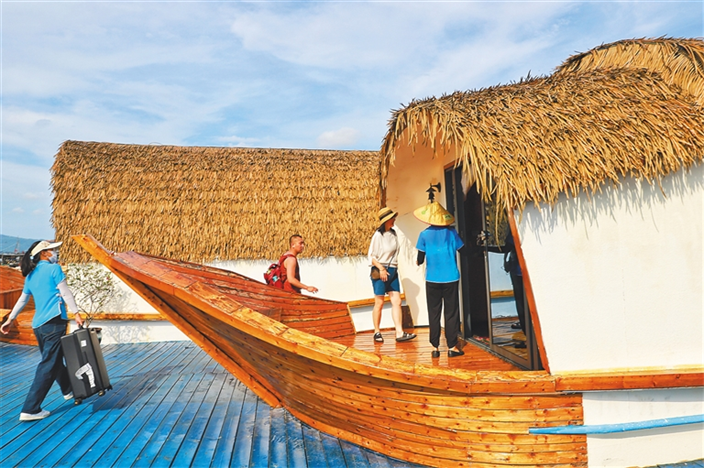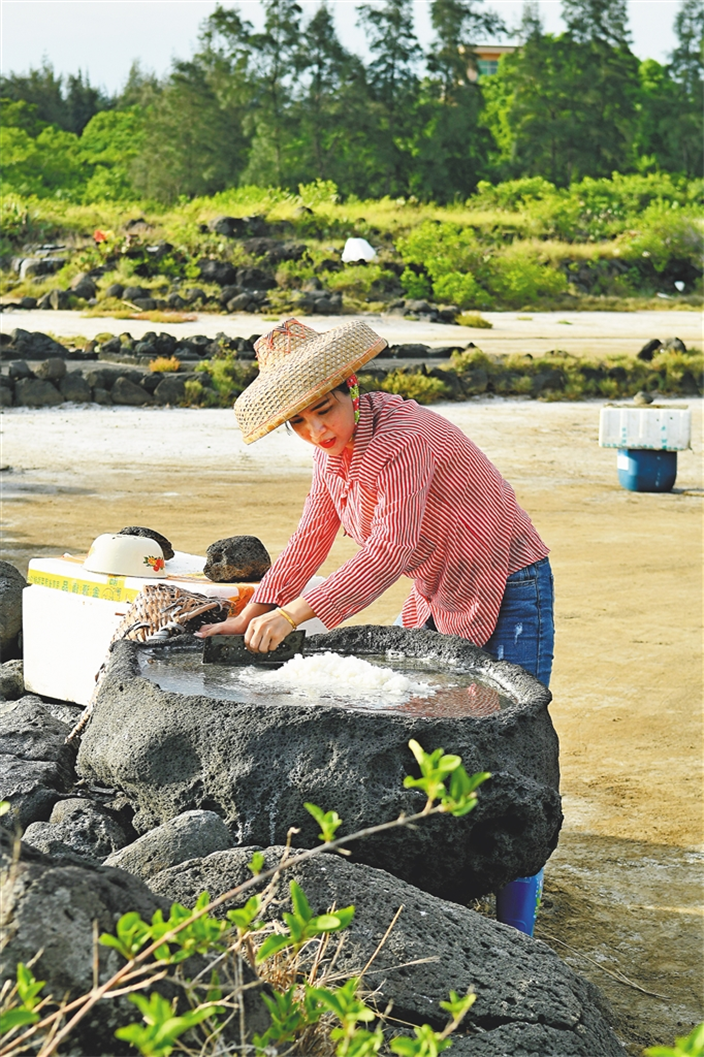By continuing to browser our site and use the services you agree to our use of cookies, Privacy Policy and Terms of Use. You can change your cookie settings through your browser.
Just a few days ago, China’s southern province of Hainan released the 2023 List of the Province’s Most Beautiful Bays. The five winners were Haikou Bay, Sanya Bay, Haitang Bay, Gancheng Harbor, and Qizi Bay. Over the past few thousand years, one of the defining attributes of the people of Hainan has been their proximity to the ocean regarding where and how they live.
Prehistoric residents on the island
Of the prehistoric sites discovered in Hainan, Changjiang’s Qiantie Cave—which is about 20,000 years old—is the oldest. Even though it is more than 100 kilometers from Hainan's west coast, the chopper cores follow the same pattern as those discovered elsewhere in southern China. This means that they must have interacted via maritime routes with the mainland.
Luobi Cave is probably the most famous prehistoric human settlement in Hainan. Sited in Lizhigou Town, northeast of urban Sanya, the site is around 10,000 years old. Barely a dozen kilometers from the coast, the site has numerous marine culture characteristics, including tools made of stone, bone, and horn that would have been used for fishing and hunting.
Lingshui's Shigong Site is a shell mound site from the mid-neolithic era. Generally found in coastal areas, shell mounds (or middens) are archaeological sites where huge quantities of shells accumulate after the contents are eaten. Featuring a variety of distinctive marine culture characteristics, Shigong—on the Nanwan Peninsula in Xincun Town—has, in addition to large quantities of ancient seashells, knapped stone tools, pottery objects, bone tools, and animal bones.
According to research by scholars, of all of the ethnic groups currently living on Hainan Island, the ancestors of the Li were the earliest to arrive. Utilizing the ocean’s rich resources, they built settlements along the coastline.
Immigrant groups in the Qin and Han dynasties
Starting from the Qin and Han dynasties (221 BCE - 220 CE), other immigrant groups began to arrive, with the ancestors of the people in Lin’gao arriving from what are now Guangdong and Guangxi and settling on the island's north side. Expanding in all directions, they had settlements as far east as modern-day Qionghai before being displaced by later arrivals.

Tourists by the seaside in Tanmen Town’s Paigang Village in Qionghai. (Photo: Hainan Daily)
During the Song and Yuan dynasties (960 - 1368), Han people from southern Fujian Province began to arrive and take over. It is from them that the Hainanese dialect, as it is spoken today, gets its Hokkien roots.
At roughly the same time, Cantonese speakers were settling where modern-day Danzhou is located, and the Tanka People were appearing in bays and inlets around the island. With the exception of the Tanka (who still live mostly on boats or in coastal areas), these groups began from coastal areas and gradually moved inland.

A Tanka Homestay in Lingshui. (Photo: Hainan Daily)
Some of Hainan's ancient villages provide signs of the ancestors’ inward migration. In Shigongque Village in Chengmai County’s Laocheng Town, locals tell the legend of their establishment by the descendants of a pair of folk heroes and military leaders from the Southern and Northern Dynasties (420 - 589). Feng Bao and Madame Xian’s connection with the village led to it being called "the Feng Clan's First Village in Hainan". In 2021, the Feng Clan Ancestral Hall in Shigongque Village was listed as a national heritage site.
Saltmaking and fishing villages
The rich products of the ocean provided a material foundation for the various people who moved to Hainan Island.
This is perhaps why, besides being known as the "jade island", Hainan was also called the "pearl cliffs" (珠崖). According to historical records, Hainan was already producing pearls as far back as the Han Dynasty (202 BC to 220 CE). By the Song Dynasty (960 - 1279), the island’s largest export was salt. Hainan’s salt-making industry’s contribution to the imperial coffers during the reign of the Song Emperor Zhenzong (997 - 1022) was more than 10,000 guan (approx. 7 million yuan).
Danzhou's E'man Town still has over 30 hectares of traditional sun-dried salt fields. According to research by the Danzhou Municipal Museum, the E’man Salt Fields began production during the Song Dynasty. These coastal, intertidal salt fields are one of China's few ancient salt-making sites still in use in the modern era.

A local woman scraping salt from a salt pan in E’man Town. (Photo: Hainan Daily)
The Qing Dynasty (1644 - 1912) Xinying Port, not far from the Xinying Central Fishing Port in Lin'gao County, was once both the island's largest fishing port and a commercial hub. Historical research has shown that, as early as the Song Dynasty, locals were already engaged in the fishery business. In modern times, although Xinying has a total population of just over 50,000 people, more than half of the population is engaged in fishery-related business, and there are more than 2,000 fishing boats. In recent years, through the development of deep-sea aquaculture, Xinying's marine industry has been getting bigger and bigger.
Port towns connecting the interior and exterior
With the increase in population, production scale expansion and commerce and trade development, some coastal settlements gradually transformed into large residential areas. Eventually, the towns that would become modern Hainan’s cities were formed. Typically, they were close to ports as their geographical advantages allowed them to be regional logistics distribution hubs connecting the interior and exterior.

Early in the morning on January 4, fishermen are selling the catch at Baimajing Central Fishing Port in Danzhou. (Photo: Hainan Daily)
During the Song Dynasty, the port town of Haikou began to develop. Supporting the island’s capital—Qiongshan Fucheng—with things like military defense, it was an essential gateway for Hainan's external relations. In the modern era, Haikou's Shenying Port (today's Baishamen area) managed, through the development of foreign trade, to gather local products from all over the island for export and to import valuable and useful items such as metals and textiles from the outside. As a result, it became an important site for industry and craft.
At the far south end of the island, the Sanya area was famous in ancient times as a place for salt. Critically important for preserving the catch in a time before refrigeration, fishermen from Fujian and Guangdong provinces would stop here to replenish their supplies. According to historical records, Sanya had two business areas: one was a block that mainly served locals and the other was a port—at the mouth of the Sanya River (where the yacht clubs are now)—that was primarily engaged in import and export as well as the salt trade and fisheries.
In 1684—the 23rd year of the reign of the Qing Emperor Kangxi—the imperial court revoked its ban on interaction with the outside world and allowed ships to go to sea for trading along the coasts and points farther out. The following year, the Qing government established the Guangdong Customs Office. Setting up nine offices across Hainan island, the main office was in Haikou as the nascent city was recognized as a likely bridgehead for foreign trade. Most of the other eight coastal locations that Guandong Customs chose for setting up offices later developed into important towns.
Discovering Mysteries Season 5, Episode 12: Love Ballad of the Rainforest Frog
05:26, 22-August-2025A Hainan media tour for journalists across 9 Asian countries
05:26, 22-August-2025Expert Talks: Hainan: New Foreign Investment Hotspot
05:26, 22-August-2025Chen Zhaozao: Life and Death on the Burma Road
05:26, 22-August-2025ASEAN Media Explore Wanning’s Cultural Treasures
05:29, 21-August-2025ASEAN Media Wowed by Sanya's "Artificial Ocean"
05:29, 21-August-2025By continuing to browser our site and use the services you agree to our use of cookies, Privacy Policy and Terms of Use. You can change your cookie settings through your browser.





